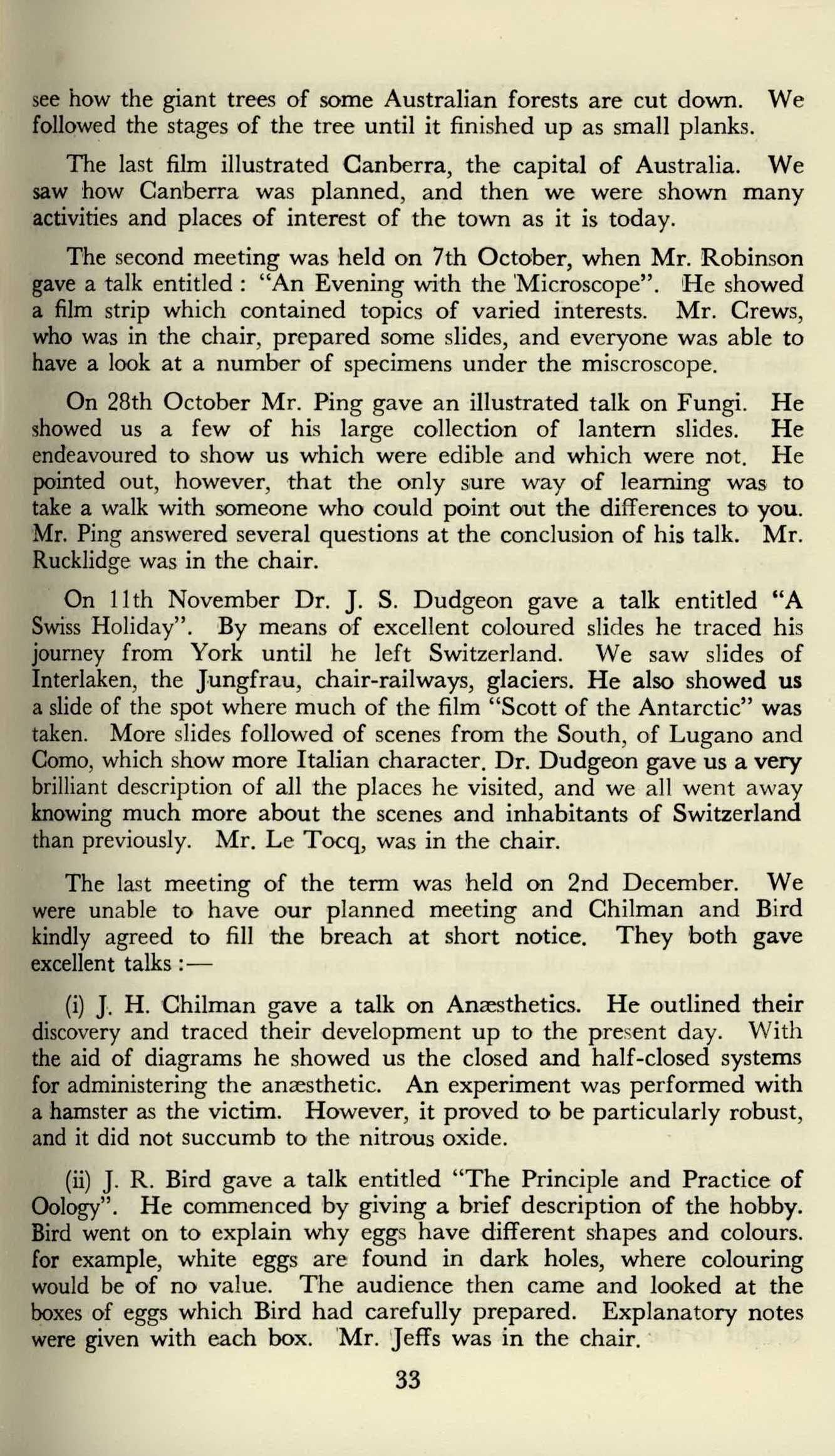
4 minute read
The Science Society
from Feb 1951
by StPetersYork
JOINT LECTURE, "THE CONCERTO" By J. T. Ankers and D. G. Hilton
On Saturday, 18th November, Ankers and Hilton delivered an interesting lecture on the growth of the Concerto. Illustrations were provided by gramophone records played on the School amplifier (operated on this, as on most occasions this year, by J. N. T. Howat). The Science Lecture Theatre was chosen for the meeting and it was comfortably filled by a representative audience drawn from all parts of the School.
Anker's task was, in a sense, the more difficult, for he dealt with the earlier composers, Cimaroso, Corelli and J. S. Bach, whose works were unfamiliar to the majority of his audience. But he had obviously prepared his subject so well, and had chosen his illustrations from among such attractive examples of his period, that he had no difficulty in carrying his audience with him. He is to be congratulated on this.
Hilton's task was, superficially, the more easy, for in presenting us with well-worn favourites like the Haydn Trumpet Concerto, the Romance from the Mozart D minor Piano Concerto, to say nothing of the finale of the Beethoven Violin Concerto, the Tchaikovski and the Grieg, he was assured of pleasing all his listeners. But with more careful selection of what he had to say, he might have succeeded in illuminating our affection for these masterpieces with some more facts on the occasion or manner of their composition.
Howat is to be congratulated on having the right side of the right record unobtrusively ready at the right time, and Hilton on the excellent organisation of the evening's activities.
President: E. K. ROBINSON, Esq., B.Sc. Hon. Secretary: J. M. BOOTH.
The system whereby the Committee was chosen has been altered this term, two representatives now being nominated by each House.
Five meetings were held this term. The first was held on 23rd September. Mr. Robinson was in the chair and four films were shown. The first was divided into two parts : The first concerned the piledriver and showed how the modern type has replaced the old one, which had many heavy accessories. The new type is petrol driven whilst the old one was driven by steam. The second, entitled "Asdic", showed us how sound waves have been adapted from their original use of searching for submarines to the more peaceful pursuit of detecting shoals of fish. It works on the echo system.
The second film was about Sheepdog Trials. It showed us the progress of one dog through all the trial. The next film enabled us to 32
see how the giant trees of some Australian forests are cut down. We followed the stages of the tree until it finished up as small planks.
The last film illustrated Canberra, the capital of Australia. We saw how Canberra was planned, and then we were shown many activities and places of interest of the town as it is today.
The second meeting was held on 7th October, when Mr. Robinson gave a talk entitled : "An Evening with the Microscope". He showed a film strip which contained topics of varied interests. Mr. Crews, who was in the chair, prepared some slides, and everyone was able to have a look at a number of specimens under the miscroscope.
On 28th October Mr. Ping gave an illustrated talk on Fungi. He showed us a few of his large collection of lantern slides. He endeavoured to show us which were edible and which were not. He pointed out, however, that the only sure way of learning was to take a walk with someone who could point out the differences to you. Mr. Ping answered several questions at the conclusion of his talk. Mr. Rucklidge was in the chair.
On 1 1 th November Dr. J. S. Dudgeon gave a talk entitled "A Swiss Holiday". By means of excellent coloured slides he traced his journey from York until he left Switzerland. We saw slides of Interlaken, the Jungfrau, chair-railways, glaciers. He also showed us a slide of the spot where much of the film "Scott of the Antarctic" was taken. More slides followed of scenes from the South, of Lugano and Como, which show more Italian character. Dr. Dudgeon gave us a very brilliant description of all the places he visited, and we all went away knowing much more about the scenes and inhabitants of Switzerland than previously. Mr. Le Tocq, was in the chair.
The last meeting of the term was held on 2nd December. We were unable to have our planned meeting and Chilman and Bird kindly agreed to fill the breach at short notice. They both gave excellent talks :—

(i) J. H. Chilman gave a talk on Anesthetics. He outlined their discovery and traced their development up to the present day. With the aid of diagrams he showed us the closed and half-closed systems for administering the anaesthetic. An experiment was performed with a hamster as the victim. However, it proved to be particularly robust, and it did not succumb to the nitrous oxide.
(ii) J. R. Bird gave a talk entitled "The Principle and Practice of Oology". He commenced by giving a brief description of the hobby. Bird went on to explain why eggs have different shapes and colours. for example, white eggs are found in dark holes, where colouring would be of no value. The audience then came and looked at the boxes of eggs which Bird had carefully prepared. Explanatory notes were given with each box. Mr. Jeffs was in the chair. 33










